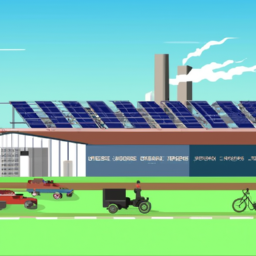Are you wondering if steel is eco friendly? Look no further. This article explores the environmental impact of steel production, the benefits of recycling steel, and how it contributes to sustainable construction. You’ll also learn about the energy efficiency of steel manufacturing and its role in reducing carbon emissions. By evaluating the lifecycle assessment of steel, we can determine just how eco friendly this versatile material truly is. So let’s dive in and uncover the facts together.
Environmental Impact of Steel Production

The environmental impact of steel production isn’t as eco-friendly as you might think. While steel is a vital material used in various industries, its manufacturing process has significant sustainability challenges. Steel production contributes to air pollution and carbon emissions, making it a major contributor to climate change.
One of the key issues is the high energy consumption involved in steelmaking. The traditional method of producing steel, known as blast furnace production, requires large amounts of coal or natural gas for heating and converting iron ore into usable steel. This reliance on fossil fuels not only depletes finite resources but also releases greenhouse gases into the atmosphere.
Furthermore, the extraction and processing of raw materials for steel production have adverse effects on land and water resources. Mining operations can lead to deforestation, habitat destruction, and water pollution from toxic chemicals used in the extraction process.
To address these concerns, environmental regulations have been implemented in many countries to mitigate the impact of steel manufacturing. These regulations aim to reduce emissions through cleaner technologies like electric arc furnaces that use electricity instead of fossil fuels. Additionally, recycling initiatives are encouraged to minimize waste and conserve resources.
Benefits of Steel Recycling

One of the advantages of recycling steel is that it’s a sustainable option. Steel recycling process involves collecting scrap steel, such as old cars and appliances, and melting them down to make new steel products. This process reduces the need for raw materials extraction and helps conserve natural resources.
Steel recycling has several environmental benefits. Firstly, it reduces energy consumption compared to producing steel from virgin materials. Recycling one ton of steel saves about 1,100 kilograms of iron ore, 630 kilograms of coal, and 55 kilograms of limestone. This results in significant energy savings and reduced greenhouse gas emissions.
Additionally, recycling steel helps reduce landfill waste. By diverting scrap metal from landfills, we can decrease pollution and conserve valuable landfill space.
Furthermore, recycling steel also conserves water resources. The production of new steel requires large amounts of water for cooling and processing purposes. By reusing existing steel through recycling processes, we can minimize the water usage associated with producing new steel.
Steel’s Contribution to Sustainable Construction

When it comes to sustainable construction, you can rely on steel to provide durability and strength. The steel industry has made significant strides in promoting sustainability and creating greener building practices. Steel is one of the most recycled materials globally, with a recycling rate of over 90%. This not only reduces waste but also conserves energy and resources. By using recycled steel in construction, the demand for virgin materials is reduced, resulting in lower carbon emissions.
Furthermore, green building with steel offers numerous environmental benefits. Steel structures are highly energy-efficient due to their thermal performance and ability to retain heat or coolness. They can also be designed to incorporate renewable energy systems such as solar panels or wind turbines, further reducing the carbon footprint of the building.
Steel’s strength allows for the creation of longer spans, which minimizes the need for additional support columns. This leads to more flexible floor plans and increased usable space within a building. Additionally, steel buildings have excellent resistance to natural disasters such as earthquakes and hurricanes, contributing to their long-term sustainability.
Energy Efficiency of Steel Manufacturing

To maximize energy efficiency in steel manufacturing, you can implement innovative techniques and technologies. By doing so, you can significantly reduce energy consumption and minimize the carbon footprint associated with steel production.
One key approach to improving energy efficiency is through the use of advanced furnace technologies. For example, electric arc furnaces (EAFs) are becoming increasingly popular due to their ability to recycle scrap steel and consume less energy compared to traditional blast furnaces. EAFs also emit fewer greenhouse gases, leading to a reduced carbon footprint.
Another technique that can enhance energy efficiency is cogeneration or combined heat and power (CHP). This process involves capturing waste heat from steel production and converting it into useful electricity or thermal energy. By utilizing this waste heat effectively, steel manufacturers can reduce their reliance on external sources of electricity and decrease overall energy consumption.
Additionally, implementing smart automation systems can help optimize various processes in steel manufacturing. These systems enable real-time monitoring of energy usage, allowing for better control and adjustment of operations to minimize wastage.
Steel’s Role in Reducing Carbon Emissions

You can contribute to reducing carbon emissions by implementing energy-efficient practices in steel manufacturing. Steel production is a major contributor to air pollution and greenhouse gas emissions, accounting for approximately 7% of global CO2 emissions. However, there are ways to mitigate this impact and transition the industry towards renewable energy sources.
One approach is improving the energy efficiency of steel manufacturing processes. By adopting advanced technologies and practices, such as using high-efficiency furnaces, optimizing heat recovery systems, and implementing recycling initiatives, significant reductions in carbon emissions can be achieved.
Another way steel can play a role in reducing carbon emissions is through its use in renewable energy infrastructure. Steel is a crucial component in wind turbines, solar panels, and other clean energy technologies. By supporting the growth of these industries, steel manufacturers indirectly contribute to the reduction of carbon emissions from fossil fuel-based electricity generation.
Furthermore, transitioning to low-carbon steel production methods like hydrogen-based direct reduction can also help reduce carbon emissions associated with steel manufacturing. This process replaces coal with hydrogen as a reducing agent for iron ore.
Evaluating the Lifecycle Assessment of Steel

By evaluating the lifecycle assessment of steel, it becomes evident that sustainable practices and materials are essential for reducing environmental impact. Steel is known for its durability and long lifespan, making it an ideal choice in various industries, including construction and renewable energy infrastructure.
In terms of durability, steel has a high resistance to corrosion and can withstand harsh weather conditions. This means that structures made from steel require less maintenance over time compared to other materials. Additionally, steel’s strength allows for lighter designs, which can lead to reduced material usage and lower transportation costs.
Furthermore, steel plays a crucial role in the development of renewable energy infrastructure. Wind turbines, for example, rely on the use of steel in their towers and foundations. Steel provides the necessary strength to support the rotating blades while withstanding strong winds. Additionally, solar panel mounting structures often utilize steel due to its stability and ability to withstand extreme temperatures.
To reduce the environmental impact of steel production further, sustainable practices need to be implemented throughout its lifecycle. This includes using recycled or scrap steel as raw material whenever possible and optimizing production processes to minimize emissions and waste.
Overall, by considering factors such as durability and lifespan as well as its use in renewable energy infrastructure projects, it is clear that incorporating sustainable practices into the production and use of steel is vital for minimizing environmental impact.
Frequently Asked Questions
What Are the Different Methods Used in Steel Production That Have the Least Environmental Impact?
When considering the methods used in steel production, it is crucial to evaluate their environmental impact. Various approaches can help reduce this impact. For instance, implementing energy-efficient technologies and recycling scrap metal minimize resource consumption and emissions. Additionally, adopting renewable energy sources during production processes can significantly decrease greenhouse gas emissions. These methods highlight the industry’s commitment to minimizing its environmental footprint while meeting global demand for steel products.
Can Steel Recycling Alone Meet the Growing Demand for Steel in Various Industries?
Steel recycling alone may not be able to meet the growing demand for steel in various industries. While steel recycling has its benefits, it also has limitations such as the quality of recycled steel and the availability of scrap. To meet the increasing demand, alternative materials for steel production should be considered. These alternatives can help reduce the environmental impact associated with steel production while still meeting industry needs. It is important to explore all options to ensure a sustainable future for steel production.
How Does the Use of Steel in Construction Contribute to the Overall Sustainability of a Building?
When considering the sustainability of a building, it is important to assess the overall environmental impact of using steel in construction. Life cycle assessment allows us to compare steel with other materials and evaluate its environmental footprint. Additionally, innovative steel technologies have been developed to further reduce its impact. By discussing these factors without the context of whether or not steel is eco-friendly, we can gain a comprehensive understanding of how steel contributes to the overall sustainability of a building.
What Measures Are Taken by Steel Manufacturers to Ensure Energy Efficiency During the Manufacturing Process?
Steel manufacturers take measures to ensure energy efficiency during the manufacturing process. They incorporate energy-efficient technologies and utilize renewable energy sources. By using advanced machinery and processes, they reduce energy consumption and minimize greenhouse gas emissions. This helps in conserving resources and reducing the carbon footprint of steel production. These practices align with sustainable principles and contribute to a more environmentally friendly steel industry.
Besides Reducing Carbon Emissions, What Other Environmental Benefits Does Steel Offer Compared to Other Materials?
Steel offers a range of environmental benefits compared to other materials. Its durability means it has a longer lifespan, reducing the need for frequent replacements. It is also highly recyclable, with a recycling rate of around 90%. Steel’s strength allows for lighter structures and more efficient use of resources. In sustainable construction, steel plays a crucial role in creating energy-efficient buildings and reducing carbon emissions. These factors make steel an eco-friendly choice for various applications.
Conclusion
In conclusion, steel is an eco-friendly material due to its various environmental benefits. Its production process has a significant impact on the environment, but with advancements in technology and recycling efforts, the industry has made great strides in minimizing these effects. Steel recycling plays a crucial role in reducing waste and preserving natural resources. Additionally, steel’s energy efficiency and contribution to sustainable construction further support its eco-friendly reputation. By evaluating the lifecycle assessment of steel, it becomes evident that this versatile material plays a vital role in reducing carbon emissions and promoting sustainability.